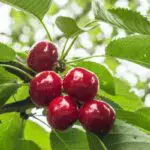Make your fruit trees more fruitful! Learn how to weigh down fruit tree branches using limb spreaders and tree weights.
When to prune fruit trees

If you're wondering when to prune your fruit trees, the answer to that question depends on your goals. Do you want to reduce the size of a vigorous tree? Or, do you want to encourage a young fruit tree to grow faster? Correct fruit tree pruning, at the right time of year, can help you achieve those goals. These examples illustrate when it's best to prune a fruit tree:
- Is your tree already getting too tall to harvest easily? Consider pruning oversized trees (such as large cherry trees) in the early spring to reduce their size.
- Do you want your young or newly planted tree to grow faster, or have you just planted a bare root tree? You can prune those in the late winter to spur vigorous growth.
There are other factors to keep in mind while considering when to prune fruit trees. Is your tree diseased? Are some of the branches broken? Does your tree produce lots of poor quality fruit? Do you live in a very cold climate, in which late summer and autumn pruning can be risky? I'm going to explore some of these questions in this article. So let's dig in!

Pruning Fruit Trees: How Timing Affects Tree Growth
In general, winter pruning encourages vigorous growth, while summer pruning slows things down. Why? It all comes down to your tree’s seasonal energy cycle. Prune at the right time, and you can guide how your tree grows.
Think of it like this: pruning is a way of giving your tree a gentle nudge. Prune in late winter, and you’re telling it to grow! Prune later in the season, and you’re asking it to take things slow. Here’s a simple visual that shows how timing affects your tree’s energy and growth.
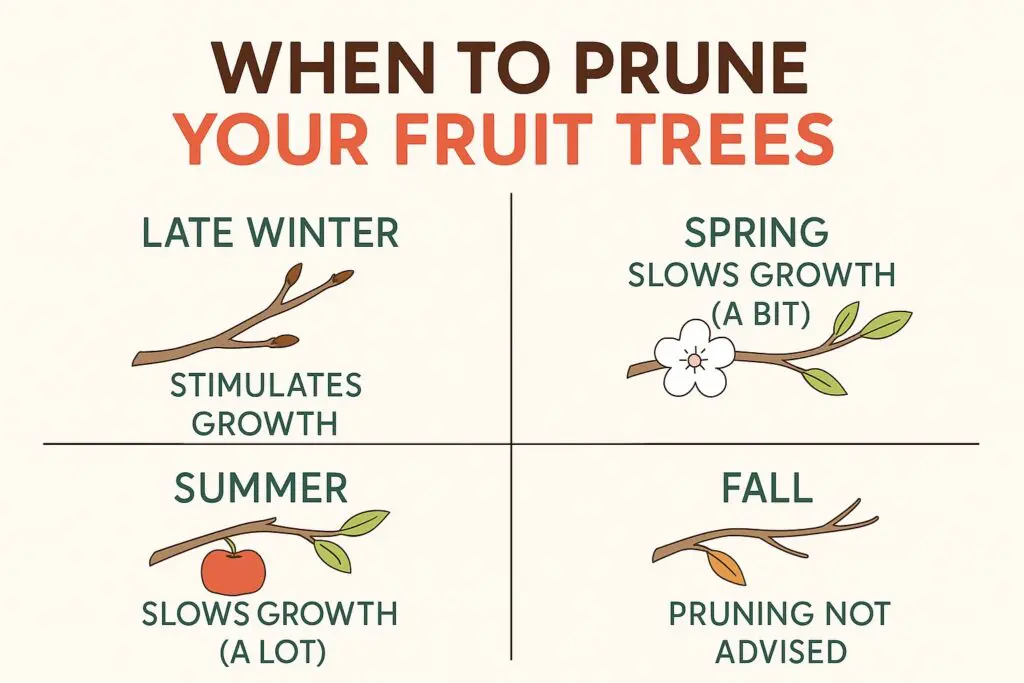
Why Fruit Tree Pruning in the Winter Spurs Growth
Winter: In the fall, fruit trees draw the energy out of their lush green leaves and into their root systems for winter storage. Once the energy has been sucked out of the leaves, those leaves will turn brown and fall off the tree. Fruit trees hardly grow at all during the winter months (their roots continue to grow, but that’s about it). So, your tree will use just a small percentage of its stored nutrients to keep it alive during the winter. Most of the remaining energy will be saved for a flurry of action in the spring, when fruit trees emerge from dormancy. Their buds break open and trees need their stored energy to fuel blossom, leaf, branch, and root growth.
Is winter a good time to prune fruit trees? If you live in a cold climate, winter pruning is indeed a good time to prune fruit trees because the tree is dormant, with no leaves, flowers, or fruit. That means it will be easy to see your tree's structure and to decide which cuts to make. And yet, some orchardists avoid fruit tree pruning in the early winter. This is because in the early winter, branch growth is minimal, and the tree cannot heal the wounds caused by pruning cuts. Late winter, however, is an excellent time to prune your trees. You can easily see the structure of your tree, and you can rest assured knowing that the spring is not far off and your tree will soon be able to heal those wounds.
Fruit Trees
That Thrive
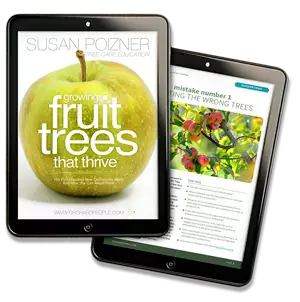
Winter pruning encourages vigorous growth: Moreover, when you prune your tree in the late winter or early spring, you will spur vigorous growth. Why? Well, because you are selecting the best branches to keep, while removing the lower quality branches. This means that when the spring comes, the tree won't waste its energy fuelling the growth of poor quality branches. Instead, it will focus that energy on the best branches.
Think about it this way: if your fruit tree has 100 branches and it needs to fuel growth in each of those branches, then each branch gets a small share of the stored energy. But if, after pruning, your tree has just 75 branches, each branch gets a larger share of that energy so it can grow longer and produce better quality fruit.
Next, let's move from the quiet of winter to early spring. How will that change the effect pruning has on your fruit tree? Read on to find out...
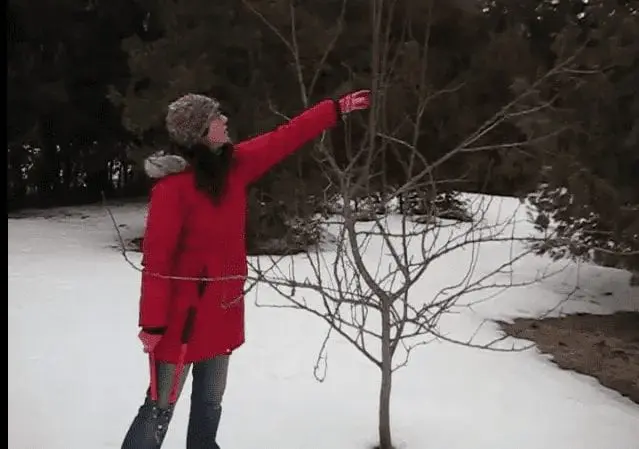
Fruit Tree Pruning in The Spring
Spring: As spring approaches, the days become longer, the weather becomes warmer, and your tree starts to emerge from dormancy. It has a wonderful stash of energy or sugars in its roots, which it will use to power spring growth. The buds on your tree will burst open, making way for leaves, blossoms, baby fruit, and new shoots to emerge.
Is spring a good time to prune fruit trees? Some orchardists like to prune in the spring after the tree's buds have opened and the blossoms and leaves have started to emerge. The benefit of pruning at this time is that you can identify (and remove) the branches that did not survive the winter. This is especially true for those who grow tender fruit trees, such as peach or apricot.
Pruning in the spring, however, will not encourage as much growth in your tree as it would if you had pruned in the late winter. That's because that tree has already used up some of its stored energy to fuel leaf, blossom, and shoot growth on its many branches before pruning. Spring is a good time to prune a large fruit tree if you want to make it more compact. You should, however, avoid pruning apple trees during blossom time because that can result in the spread of a common apple tree disease called fire blight.
Now, with the lively growth of spring well underway, let's look at how the summer months offer unique opportunities and challenges for pruning.
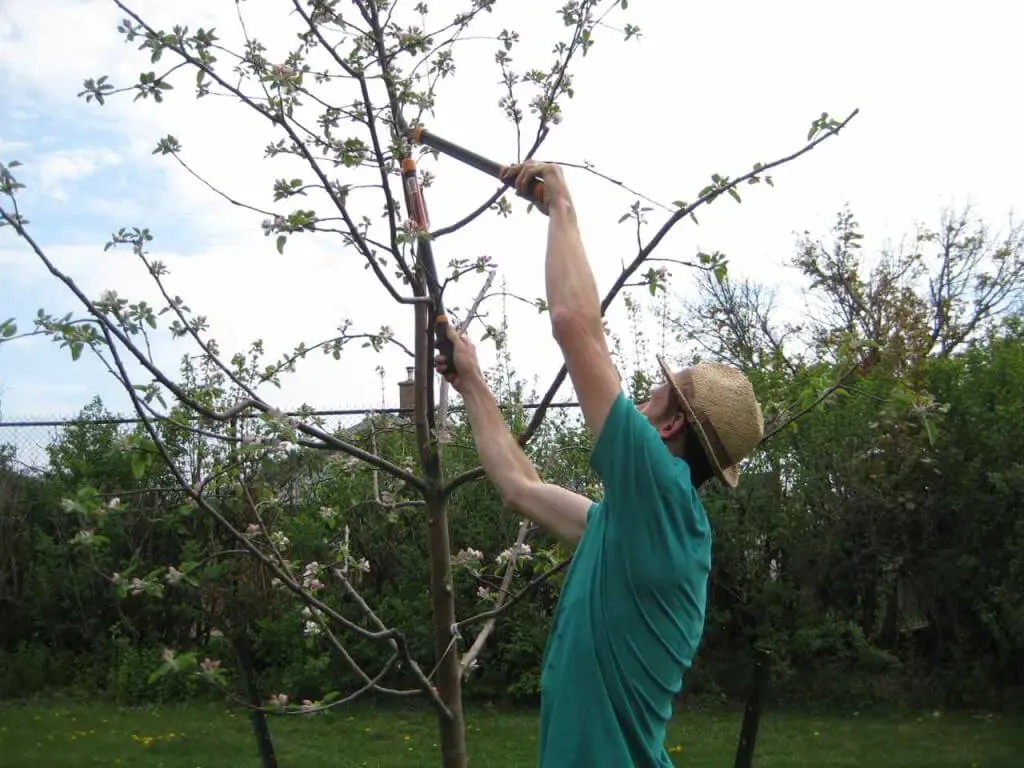
Fruit Tree Pruning in the Summer
Summer: Wow! The spring was a busy time for your tree! But once spring growth slows and the stored nutrients are used up, your tree can use the rest of the summer to rebuild its nutrient stockpile. Now fully leafed out, it will produce energy through photosynthesis, and will use some of that energy to fuel summer growth. The remaining energy will eventually be drawn back into the roots in the winter, when the cycle starts again.
Is this a good time to prune fruit trees? It can be. Summer pruning has many benefits. Because your tree doesn't have a stockpile of energy, it won't grow vigorously as a result of the summer pruning, so this can help you reduce the size of a larger tree. Great candidates for spring or summer pruning include cherry trees, which, if left alone, can grow up to three stories tall! You may also want to prune an old apple tree in the summer to reduce its size.
Even if your primary pruning session took place in the winter or early spring, you can continue pruning in the summer. This is the time to will remove any new growth branches that are broken, crisscrossed (and rubbing up against each other), or diseased.
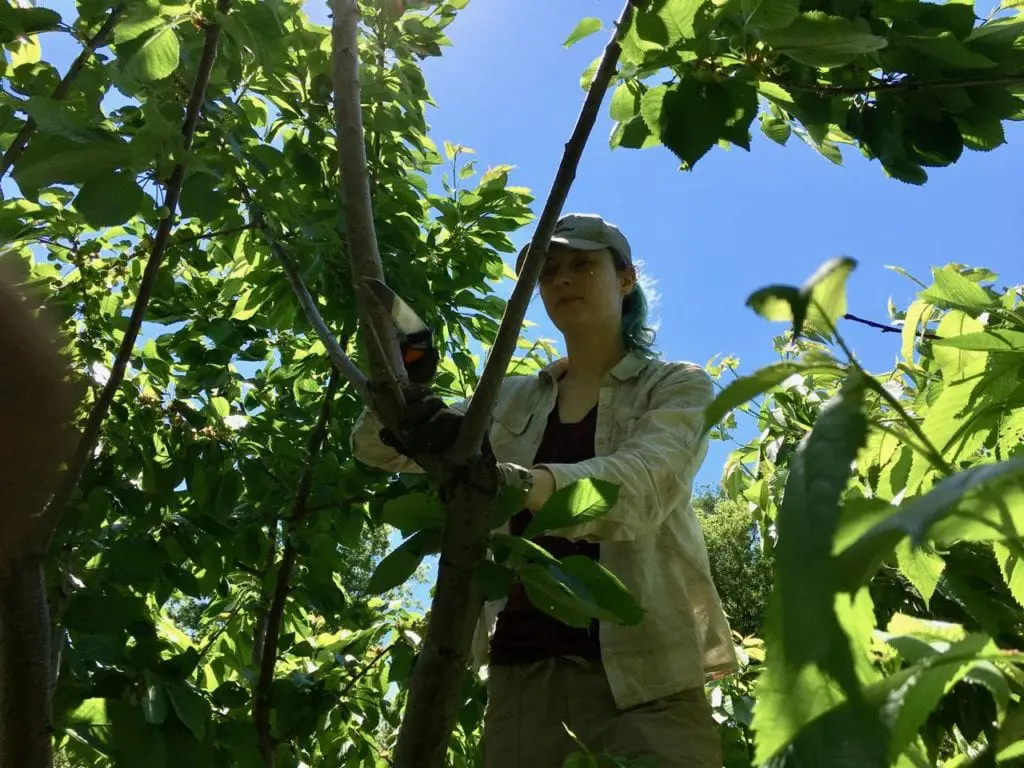
Why Fruit Tree Pruning in the Autumn is Not Wise
Autumn: After a summer of sunshine, your tree has produced a large amount of food for itself. It does this through photosynthesis: a process by which your tree turns the light of the sun into sugars that are stored in its leaves. As the weather cools, the tree prepares for dormancy by moving those sugars down into its roots for winter storage.
Is this a good time to prune fruit trees? Well, if you live in a cold climate, autumn pruning is not a great idea. That's because every time you cut a branch off of a tree, you will leave behind a pruning wound. That's not a problem during the growing season. Within days your tree will start healing the wound with a layer of protective cells. But in the fall, growth has slowed and that may not happen.
Pruning Diseased Fruit Trees
Are you wondering when to prune fruit trees that are diseased? Well, you can actually do this at any time of year. In the winter, it tends to be easier to see disease problems, as the branches of your tree are bare. However, you may choose to wait until late winter to ensure that the wound will heal quickly afterwards. Also, most diseases are dormant in the winter months. But if you see a diseased branch in winter or summer, it's usually a good idea to remove it so the disease (like black knot, canker, or fire blight) doesn't spread within the tree and to neighbouring trees. It is important to be able to identify the disease problem, to know if pruning is an effective treatment, and to know how much is necessary to cut off.
Fruit Trees
That Thrive

Q&A on Fruit Tree Pruning
Q: What is fruit tree pruning and how is it different from pruning native or ornamental trees?
A: Fruit tree pruning is a specialized form of pruning. With fruit tree pruning, our goal is to enhance fruit production and improve the health of the tree. In contrast, pruning native or ornamental trees focuses on removing dead and diseased branches and aesthetics. To prune fruit trees you need a deeper understanding of the tree's growth patterns, fruiting habits, and how cuts will affect future growth and fruit production.
Q: When do I start pruning my fruit tree?
A: You should start pruning your fruit tree on the very day you plant it, especially if you are planting a bare root fruit tree! Early pruning is crucial to developing a strong structure fruit bearing structure for your tree. To see exactly how to do this, watch the video below. It will guide you through the initial pruning steps.
Q: Is it necessary to treat the cuts after pruning?
A: It's not necessary to treat pruning cuts with wound paint or sealant. If you prune during the growing season, your trees will start sealing their own wounds in the days and weeks after you make your cuts. They do this by producing microscopic layers of cells that become callus tissue. Still, for certain diseases like fire blight in apples and pears, you should sterilize your pruning tools between cuts to prevent spreading the disease.
Q: How often should I prune my fruit trees to maintain optimal health and productivity?
A: How often you prune your fruit trees will depend on the age and type of your fruit tree. Young trees need more frequent (and more extreme!) pruning to establish a strong structure, typically once a year. Mature trees might need less frequent pruning, often every 2 to 3 years, focused on maintenance tasks like removing dead or diseased wood and thinning to improve light penetration and air circulation. Monitoring your tree's growth and health annually is key to determining the need for pruning.
Q: What tools do I need for effective fruit tree pruning, and how do I care for them?
A: Essential tools for fruit tree pruning include a sharp pair of pruning shears for small branches, loppers for medium-sized branches, and a pruning saw for large branches. Watch the video below to see some of my favourite tools. Keeping your tools clean and sharp ensures clean cuts that heal quickly, reducing the risk of disease.
Q: What's the difference between thinning and heading cuts, and when should I use each?
A: Thinning cuts remove entire branches or limbs at their point of origin, improving light and air circulation within the canopy and encouraging fruit production on remaining branches. Heading cuts shorten branches, encouraging denser growth near the cut. Use thinning cuts to shape the tree and improve its health and heading cuts to control the height and spread of the tree.
Q: Where can I learn more about specific pruning techniques for different types of fruit trees?
A: For more detailed lessons on pruning specific types of fruit trees, sign up for my self-study, instant-access online course "Certificate in Fruit Tree Care" or the "Fruit Tree Pruning Masterclass".

Susan Poizner
Learn more about Susan on the about us page.



